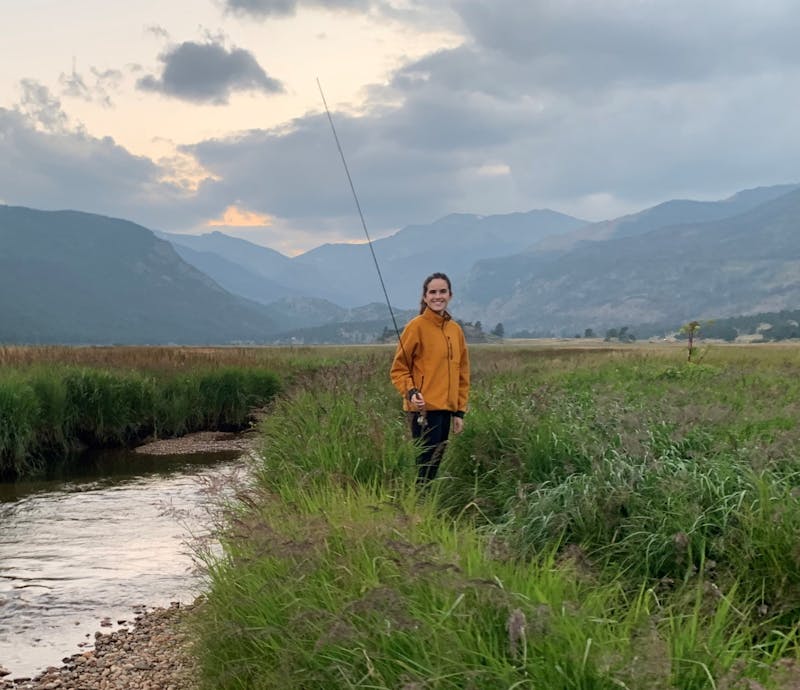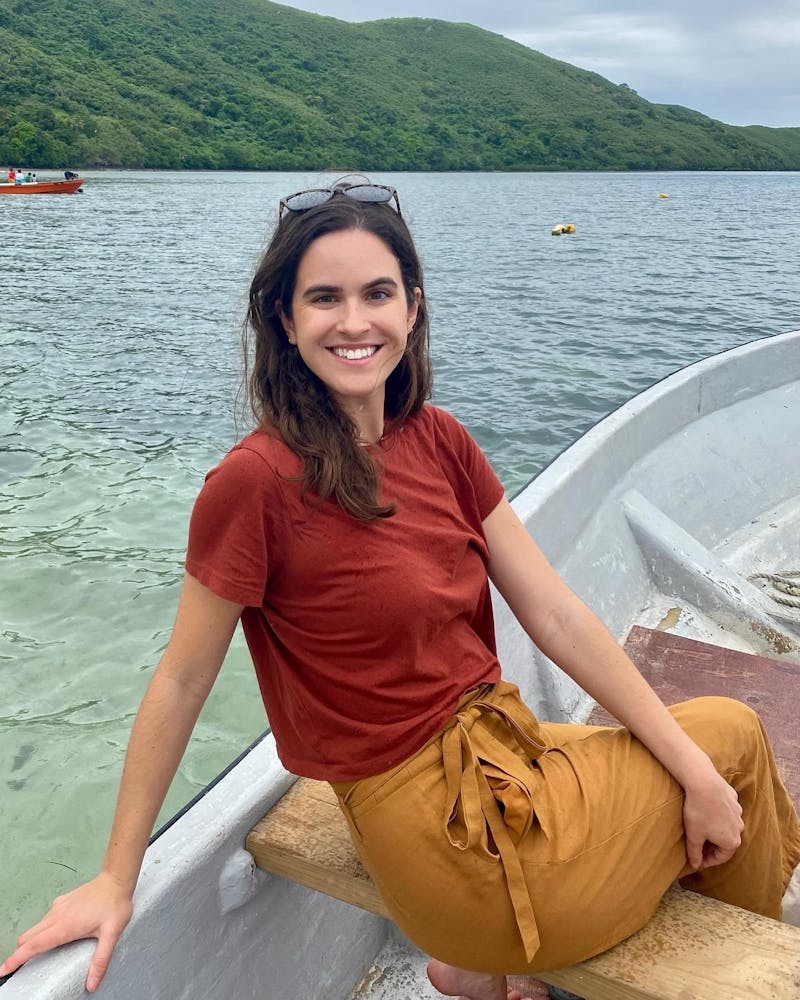Growing up in Colorado’s Rocky Mountains, Jill Hamilton always felt connected to nature — and knew she would pursue a career to protect it. But time spent on the coast with family drew her from the mountains to the ocean.
Now at Conservation International, she works at the intersection of policy and ocean science — helping governments and decision-makers protect marine and coastal ecosystems. Conservation News spoke with Hamilton about how she transformed a passion for the outdoors into a career in international policy — and her advice for others seeking to do the same.
What drew you to the ocean?

Jill Hamilton fly fishing in Colorado.
Jill Hamilton: While I grew up near the mountains, I spent a lot of time with my extended family, who live on the California and Rhode Island coasts. I have always felt that a love for the ocean is in my blood. For generations, many of my relatives — including my grandfather and uncles — worked as fishermen, sailors and in the Coast Guard.
But I really started to think about a career in ocean conservation in college, when I took a course that required me to get scuba certified. I’ll never forget the first time I went diving in the ocean. My class traveled to Cozumel, Mexico, which is known for its beautiful underwater arches and tunnels, not to mention marine life. We saw angelfish, spotted eagle rays and small eels in beds of seagrass. When you’re 40 feet under water and swimming above a coral reef, it feels like you’re flying — there’s no other way to describe that sensation.
On future research trips, I met people working to protect coral reefs. They did underwater surveys of the reefs, then used the findings to develop management plans and conservation policies. I was intrigued by this work and wanted to learn more.
How did that experience lead you to international policy?
JH: In graduate school, I had the opportunity to go to Cuba and Mexico for meetings about environmental collaboration in the Gulf of Mexico. Ocean currents connect marine life off the coasts of the United States, Mexico and Cuba. For example, a grouper born in Cuba’s reefs might mature in the waters of Texas or Florida; sea turtles migrate within the entire region and whale sharks can be found in many corners of the Gulf. This dynamic ecosystem supports the three countries’ economies and communities. And despite their political differences, countries have worked together to rise above the challenges. Seeing this made me feel hopeful — I knew I wanted to be part of making that happen.
Now, in my work at Conservation International, I advise governments and other global decision-makers, like the United Nations climate change secretariat, on how mangrove and seagrass conservation and restoration can help address the impacts of climate change. Greenhouse gas emissions are warming and acidifying the ocean, which is harming marine life and causing increasingly intense storms. Given the scale of the threats, countries, the private sector and others all need to work together on solutions.
How does your work address these threats?

Jill Hamilton in Fiji.
JH: My work is mainly focused on what we call blue carbon ecosystems, which include mangroves, seagrasses and tidal marshes that absorb and store huge quantities of carbon. Along with cutting fossil fuel emissions, conserving and restoring these ecosystems is one of the best ways to fight climate change. Plus, they offer protection from storms and provide numerous benefits for local communities. But they need protection — more than a third of the world’s mangrove forests have been destroyed since 1980.
How can your work address these challenges?
JH: Whether we’re working with partners or governments in Fiji, Indonesia or Costa Rica, their concerns and challenges are often quite similar — which also means there are shared solutions. An important part of my job is helping countries identify these similarities and find ways to incorporate proven solutions into their own plans to curb climate change.
In just a few weeks, countries will meet for the annual United Nations Climate Change Conference to negotiate responses to the climate crisis. To help countries shape realistic and ambitious climate goals for their coastal ecosystems, Conservation International recently published a resource guide that identifies ways to protect mangroves and other coastal blue carbon ecosystems — and make them part of countries’ climate change commitments. Ensuring these ecosystems are part of a broader plan helps countries secure funding and conserve and restore these important places long into the future.
For example, we’re currently working with the government of Indonesia to incorporate blue carbon ecosystems into their national climate and biodiversity goals to protect them from threats like aquaculture and agriculture. Conserving and restoring Indonesia’s mangroves — which account for one-fifth of the world’s total — is incredibly important for protecting coastal communities and curbing climate change. In addition to providing protection from intensifying storms and rising seas, Indonesia’s mangroves store 3.1 billion tons of carbon — that’s equivalent to the annual emissions of 2.5 billion cars.
Ultimately, my role sits at the intersection of science and policy. We have proven solutions to restore and conserve blue carbon ecosystems. Now we need to work with governments and other partners to put the policies and financing strategies in place so we can scale up these solutions and have global impact.
What message do you have for others who would like to pursue a career in conservation?
JH: Follow what excites you. My career has taken me from renewable energy to managing migratory tuna stocks to the United States Senate, where I helped draft a bill on blue carbon. There are many ways to contribute to conservation, it can take time to find your niche. My passion for the ocean and protecting nature has guided me along the way, and each of these experiences continue to influence my work today.
Mary Kate McCoy is a staff writer at Conservation International. Want to read more stories like this? Sign up for email updates. Also, please consider supporting our critical work.